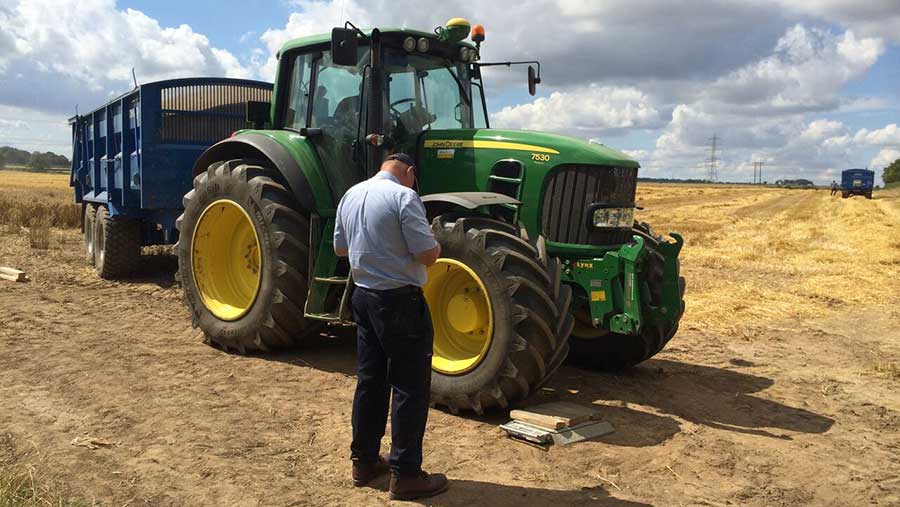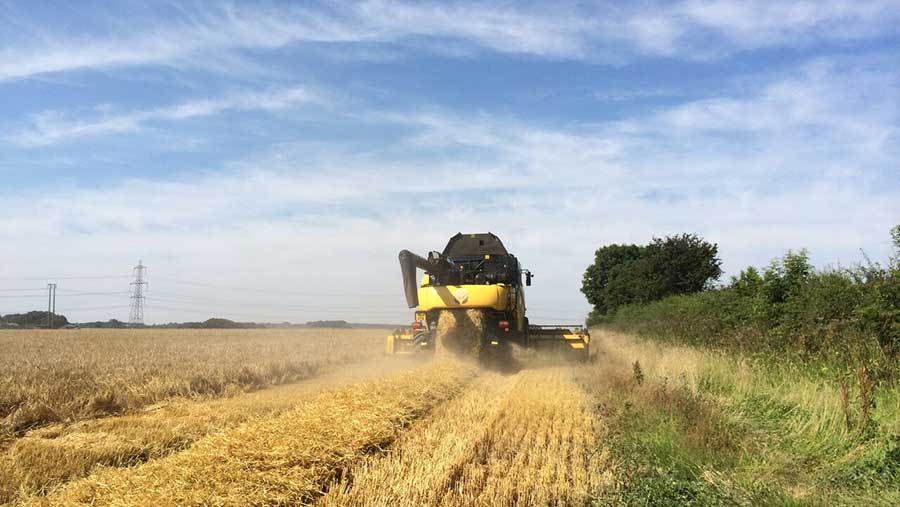How data helps growers make good crop husbandry decisions
 © Tamara Hall
© Tamara Hall A range of tools and equipment has taken time and educated guesswork out of cropping decisions at an East Yorkshire arable farm.
Precision farming came to Molescroft Grange Farm in 2007 with N-Sensor, following a move to liquid nitrogen.
With an engineering background, Tamara Hall, managing director of the family farming company, was keen to use more technology to remove variables and make the business more efficient.
A few hours spent measuring tramline widths on Google Maps resulted in the introduction of auto-steer on the farm’s tractors as they were replaced.
Molescroft Grange Farm
- 627ha arable on wide range of soils
- Wheat, barley, oilseed rape, beans, vining peas, three year grass leys for haylage
- 10% of land in stewardship
- 65 community allotments, community orchard, office lets
Tramline accuracy
“I found that while often the tramlines were surprisingly close to 24m (and hence the drill was running at the full width of 6m), quite a few were significantly less than 24m, so on that portion we were using a certain percentage [of] extra chemicals and other inputs each year,” says Ms Hall.
“It was fairly easy to work out how quickly this would pay back on the drill tractor.”
With a crossover of just 24cm on a 24m pass giving a 1% overspend, the saving was easy to work out.
Also, working at full width on cultivations brings savings on fuel, wearing parts and time on other operations.
“There’s also the question of reducing operator fatigue and safety, which is hard to quantify but is an obvious benefit.”
See also: EID tag system helps bolster stock margins
Even crops
The N-Sensor delivers more even crops, in particular less lodging on headlands, as well as lower combining and drying costs.
“In addition, because you have more even crops, the challenge of harvest is slightly less because you have wider windows for combining in that you’re not waiting for those last bits to be in a state where they will go,” says Ms Hall.
Tractor driver Peter Huzzard is the only full-time employee on the farm. He has been at Molescroft Grange for 15 years and sees a big difference in how even crops are now, compared with, say, 10 years ago.
The Absolute N program for oilseed rape is where N-Sensor is most useful, says Ms Hall.
“Absolute N reads the crop and decides itself how much [nitrogen] to apply, rather than [on cereals] you telling it what average rate of nitrogen you want and the programme then adjusting up and down according to the thickness of the crop.
“The first year we used it was rather scary – it applied only about 120kg N/ha on some heavy land.
“We went back and applied about another 60kg N/ha as we didn’t trust the program!
“However we left some areas at 120kg and were amazed to find no difference in yield on the 120kg fields and the 180kg fields.
“Since we usually use about 220kg on our rape, 120kg is very low. And my idea of varying the nitrogen if the crop was forward had been to drop the N by just 20-30kg.
“We now trust the N-Sensor and wish they would find a way to make it work for other cereals.”

© Tamara Hall
Soil nutrient testing
After buying a new combine with yield monitoring in 2008, the team began testing P, K, pH and Mg levels, taking one sample per hectare.
“We couldn’t believe how much variation there was. Clive Blacker from consultancy Precision Decisions showed me how to make the variable rate plans for this on Gatekeeper.”
There was little correlation between the yield maps and the P and K maps, which was both surprising and disappointing.
“In one field for example, the P was only 0.8 in one area but this was the highest-yielding area of the field.”
“We have decided now that P and K are not as limiting a factor as soil moisture and soil structure.
“We have mostly grade 3 land, with rather a lot of it seasonally waterlogged. However, the crops do not get stressed in the summer so I think they can cope with lower P and K, although most of our levels are now correct at 2 and 2+.”
Challenging convention
Accumulating a growing level of data about yields and farm performance has led Tamara to question conventional approaches, including whether adequate trials were used to produce the levels used in P and K text books.
“If the soil structure is right and soil microbiology is right, perhaps we can crop cereals with a P and K of 1?
“In 2010, Mr Blacker suggested testing some of the farm for conductivity. We did some and then tested the rest of the farm in 2011, as the results looked very close to what we knew soil variability to be.
“From this we made variable seed rate plans and have found this to be by far the most useful adjustment for us.
“Our soil types are incredibly varied – from sand to clay and black organic, plus some wold land. A wide range occurs within individual fields and there is blackgrass on the areas of high conductivity.”
Blackgrass likes high conductivity land and establishment can be poor on these areas.
Preserving soil structure
“In a dry year we have cloddy seed beds and in wet years, slug problems. I do not want to overwork the rest of the field to get these areas right – I am a great believer in not messing with soil any more than necessary, and so can increase the seed rate here.
“We find competition is the best blackgrass control – we are so wet that we cannot do late drilling or rely on spring cropping. Plus if you get good crop establishment the soil structure improves and the land works better the following year.”
Blackgrass is also being tackled with three-year grass leys rented to a local haylage business.
Refinements to come
Looking ahead, Ms Hall is keen to refine seed rate adjustment. “You need to increase by perhaps 50% to get enough seed in a bad area but not to cut the seed rate by such a big percentage to get a noticeably thinner crop. Every year I mean to count tillers in the spring but run out of hours.”
Adopting variable-rate seeding has not been without its challenges, however.
“We drill oilseed rape on a custom-made Challenger Agri subsoiler, using a Techneat seeder.
“We finally got the variable seed rate controller working this summer but had to stop as due to the low thousand grain weight of rapeseed, the seeder cut out when it reduced to just 1.75kg/ha on the best areas drilled in mid-August.”
It has been adapted so variable-rate oilseed rape drilling should go ahead next summer.
How data helps with decisions
- Promotes most efficient use of resources, for example, takes guesswork out of seed rate calculations – improves seed efficiency and reduces seed spend
- Marginal gains such as small improvements from measuring tramline accuracy can lead to significant savings
- Need for overworking and reworking reduced – data helps determine variable-rate seeding, protects soil structure
- Auto steer improves input efficiency on both variable and fixed costs
- Yield and soil data allows more accurate input purchase, seed rate and fertiliser placement calculations, leading to more even crop and so, in the case of oilseed rape, less pigeon damage
Follow Molescroft Grange Farm on Twitter

